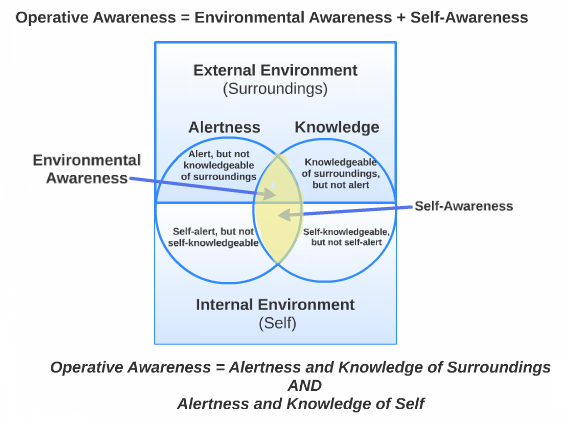Operative Awareness is awareness that is functionally useful. It has an actual effect on your assessments and actions.
“Be aware of your Surroundings” is an extremely common sound bite of self-defense. The general idea is that by being “aware” you are less likely to be victimized by a criminal. Many people who promote awareness for self-defense also use the Cooper Color Codes in order to show a model for how awareness is used. The model is applied to a self-defense/threat scenario to illustrate how a person’s level of awareness changes and escalates as the situation progresses and becomes more dire.
This is all well and good, except that the concept of awareness instruction usually ends with the Cooper Color Codes or some other similar model. This is a form of Single Loop Learning, you get the basic idea and that’s as far as it goes. The problem arises when you think that the basic idea is the entire concept. For example, you can add, subtract, multiply, and divide, so you decide you understand mathematics. No need to look deeper into the subject since “you got it”. On the other hand, Double Loop Learning requires that you now expand, deepen, and evolve your understanding to a higher level.
Just as math is more complex than basic operations, awareness more complex than having an increasing level of attention to some person or to some situation. Operative Awareness as a means of increasing personal safety is made up of the two categories of Environmental Awareness and Self-Awareness. These two categories subdivide further as follows:
Environmental Awareness
1. Alertness to Environment.
2. Knowledge of Environment.
Self-Awareness
3. Alertness to Self.
4. Knowledge of Self.
Generally speaking, most instructional descriptions of the importance of awareness revolve around Alertness to Environment. You must be attentive to what is happening around you. In teaching scenarios described, knowledge of the environment and knowledge of “what to do next” seems to be a given. But this knowledge is not a given. Being “on the lookout”, doesn’t really help you if you don’t know what you are looking for.
And once you do “see” an indication of something, you need to know what to do next. What to look for and what to do is highly dependent upon the particular environment that you are in. What works in one part of Town may backfire in another part of Town (let alone a different country or culture) and vice-versa.
Part of Double Loop Learning for awareness is Environmental Knowledge.
Going further, it is important to understand that a person’s perceptions and viewpoint are greatly influenced by personal bias, experiences, cultural norms, upbringing, specific training, individual attributes, and more. That means that two people will “see” the exact same event differently. Thus, they will most likely draw different conclusions on the significance and meaning of that same event.
Realizing that you and another person with the same level of alertness and knowledge of the environment can draw two different conclusions to the same stimulus is an important part of Self-Awareness. You are alert to the fact that what you “see” is actually “what you think you see”. The more in tune you (aware) are to how your individual nature effects your perceptions the greater your Alertness to Self. Contrast this idea to people who are unwilling to accept that they may view the world with ideologically colored glasses.
But it is not enough to only realize that your personal bias and much more influence your perceptions, you need to have knowledge on how it happens in order to actively counter it. You need to acquire Knowledge of Self to have Self-Awareness. That requires more Double Loop Leaning.
Having Knowledge of Self entails having an understanding of how your body and brain actually function in different situations. How the different parts of your body and brain interact and effect your perceptions. For example, understanding that certain situations and stimulus will cause your emotion based Limbic System (Monkey Brain) to hijack control of your thinking helps you to use your Neo-cortex (Human Brain) to take back control. For example, engaging is tribalism is a sure way to promote emotional (Limbic) thinking. Realizing that you have “gone tribal”, is the first step to using your conscious mind to override the Limbic System and go back to rational thought processes.
By all means “Be aware of your surroundings” to help keep you safe. Just realize that your surroundings include both your environment and yourself. And being operationally aware also means knowing what look for and what to do in those environments.
Related:
What’s Wrong with Your Situational Awareness – Garry Smith & Marc MacYoung
Environmental Knowledge – Marc MacYoung
Self-Defense Competency: Environmental Knowledge, Rule Knowledge, and Domain Knowledge – Erik Kondo
